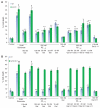Endogenous galanin protects mouse hippocampal neurons against amyloid toxicity in vitro via activation of galanin receptor-2
- PMID: 21471641
- PMCID: PMC3145121
- DOI: 10.3233/JAD-2011-110011
Endogenous galanin protects mouse hippocampal neurons against amyloid toxicity in vitro via activation of galanin receptor-2
Abstract
Expression of the neuropeptide galanin is known to be upregulated in the brain of patients with Alzheimer's disease (AD). We and others have shown that galanin plays a neuroprotective role in a number of excitotoxic injury paradigms, mediated by activation of the second galanin receptor subtype (GAL2). In the present study, we investigated whether galanin/GAL2 plays a similar protective role against amyloid-β(Aβ) toxicity. Here we report that galanin or the GAL2/3-specific peptide agonist Gal2-11, both equally protect primary dispersed mouse wildtype (WT) neonatal hippocampal neurons from 250 nM Aβ1-42 toxicity in a dose dependent manner. The amount of Aβ1-42 induced cell death was significantly greater in mice with loss-of-function mutations in galanin (Gal-KO) or GAL2 (GAL2-MUT) compared to strain-matched WT controls. Conversely, cell death was significantly reduced in galanin over-expressing (Gal-OE) transgenic mice compared to strain-matched WT controls. Exogenous galanin or Gal2-11 rescued the deficits in the Gal-KO but not the GAL2-MUT cultures, confirming that the protective effects of endogenous or exogenous galanin are mediated by activation of GAL2. Despite the high levels of endogenous galanin in the Gal-OE cultures, the addition of exogenous 100 nM or 50 nM galanin or 100 nM Gal2-11 further significantly reduced cell death, implying that GAL2-mediated neuroprotection is not at maximum in the Gal-OE mice. These data further support the hypothesis that galanin over-expression in AD is a neuroprotective response and imply that the development of a drug-like GAL2 agonist might reduce the progression of symptoms in patients with AD.
Figures


Similar articles
-
The galanin receptor 2/3 agonist Gal2-11 protects the SN56 cells against beta-amyloid 25-35 toxicity.J Neurosci Res. 2010 Apr;88(5):1064-73. doi: 10.1002/jnr.22278. J Neurosci Res. 2010. PMID: 19885864
-
Galanin protects amyloid-beta-induced neurotoxicity on primary cultured hippocampal neurons of rats.J Alzheimers Dis. 2010;20(4):1143-57. doi: 10.3233/JAD-2010-091234. J Alzheimers Dis. 2010. PMID: 20413891
-
[Galanin increases the survival rate of hippocampal cells injured by H2O2 in vitro].Fen Zi Xi Bao Sheng Wu Xue Bao. 2006 Oct;39(5):391-8. Fen Zi Xi Bao Sheng Wu Xue Bao. 2006. PMID: 17117548 Chinese.
-
Agonists of galanin subtype 2 receptor may prevent pancreatic cancer and agonists of angiotensin II type 2 receptor may prevent colorectal cancer.Eur J Pharmacol. 2024 Sep 5;978:176772. doi: 10.1016/j.ejphar.2024.176772. Epub 2024 Jun 24. Eur J Pharmacol. 2024. PMID: 38925290 Review.
-
Galanin receptor antagonists : a potential novel pharmacological treatment for mood disorders.CNS Drugs. 2006;20(8):633-54. doi: 10.2165/00023210-200620080-00003. CNS Drugs. 2006. PMID: 16863269 Review.
Cited by
-
Temporal-Spatial Profiling of Pedunculopontine Galanin-Cholinergic Neurons in the Lactacystin Rat Model of Parkinson's Disease.Neurotox Res. 2018 Jul;34(1):16-31. doi: 10.1007/s12640-017-9846-2. Epub 2017 Dec 7. Neurotox Res. 2018. PMID: 29218504
-
Characterization of the Rat GAL2R Promoter: Positive Role of ETS-1 in Regulation of the Rat GAL2R Gene in PC12 Cells.Mol Neurobiol. 2017 Aug;54(6):4421-4431. doi: 10.1007/s12035-016-9986-z. Epub 2016 Jun 27. Mol Neurobiol. 2017. PMID: 27349435
-
Maternal Choline Supplementation Alters Basal Forebrain Cholinergic Neuron Gene Expression in the Ts65Dn Mouse Model of Down Syndrome.Dev Neurobiol. 2019 Jul;79(7):664-683. doi: 10.1002/dneu.22700. Epub 2019 Jun 9. Dev Neurobiol. 2019. PMID: 31120189 Free PMC article.
-
Myocardial protection from ischemia/reperfusion injury by exogenous galanin fragment.Oncotarget. 2017 Mar 28;8(13):21241-21252. doi: 10.18632/oncotarget.15071. Oncotarget. 2017. PMID: 28177906 Free PMC article.
-
Galanin Receptors (GalR1, GalR2, and GalR3) Expression in Colorectal Cancer Tissue and Correlations to the Overall Survival and Poor Prognosis of CRC Patients.Int J Mol Sci. 2022 Mar 29;23(7):3735. doi: 10.3390/ijms23073735. Int J Mol Sci. 2022. PMID: 35409094 Free PMC article.
References
-
- Haass C, Selkoe DJ. Cellular processing of beta-amyloid precursor protein and the genesis of amyloid beta-peptide. Cell. 1993;75:1039–1042. - PubMed
-
- Glenner GG, Wong CW. Alzheimer’s disease: initial report of the purification and characterization of a novel cerebrovascular amyloid protein. Biochem Biophys Res Commun. 1984;120:885–890. - PubMed
-
- Selkoe DJ. Amyloid beta-protein and the genetics of Alzheimer’s disease. J Biol Chem. 1996;271:18295–18298. - PubMed
-
- Selkoe DJ. Alzheimer’s disease is a synaptic failure. Science. 2002;298:789–791. - PubMed
Publication types
MeSH terms
Substances
Grants and funding
LinkOut - more resources
Full Text Sources
Molecular Biology Databases
Research Materials

